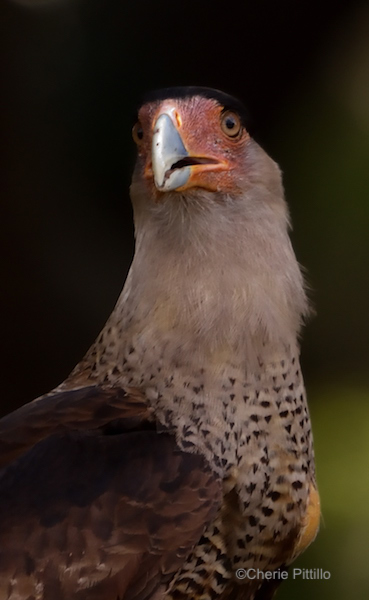What if you see a photo with a series of hearts on a bird’s neck and chest feathers? Would you immediately feel kindly toward this bird? Maybe you never thought about feathers forming heart patterns, but you now see they exist. Awwww, sweet!

If this bird were a falcon in the hawk family, would you perhaps like it?
But would that perception change when you look at an image of this bird with the hearts on its feathers eating road kill?

Would you literally turn up your nose and perhaps feel or think disgusting thoughts?
What if I make puns and state that this falcon, the Crested Caracara, is a gore-met diner, not a gourmet? Or it looks as if it sports a bad toupee? What if the armadillo is a former shell of itself and now in shell shock? How about that the caracara is carrying on over carrion?

Would that somewhat lighten any negativity?
My point is the Crested Caracara is part of nature’s clean-up crew. And yes, it does kill and feed on live prey. However, it seems we associate negative thoughts to those critters that feed on animal carcasses such as hyenas, opossums, and vultures…usually called buzzards in the USA. (And yes, I know that hyenas also kill prey and are not just scavengers.)
Even though hawks and certain other birds of prey also eat carrion, they may have escaped the “ewwww, filthy, ugly animal” character assassination.Yet, look at the Bald Eagle, a symbol for the United States of America since 1782. If the founding fathers knew how it opportunistically fed on many dead animals other than prey it killed, would the eagle have found support to represent the United States?
By the way, let me digress, Benjamin Franklin never recommended to Congress that the Wild Turkey serve as the national bird of the USA on the Great Seal. He did write a letter to his daughter to cite the bald eagle as “a Bird of bad moral Character.” He referenced the original design on the Great Seal that it looked more like a turkey. Compared to the eagle, it is “a much more respectable Bird…though a little vain and silly.”
It seems we tend to categorize animals immediately on how cute or “ugly” they are. How often are vultures and hyenas positioned as villains in movies, cartoons, tv shows, and sometimes even in nature documentaries? And does research favor those animals we want to hunt or the pretty ones or the stuffed animals we loved as kids or ones located in a beautiful locale?
For example, look at a few birds that clean up highways of dead prey such as the Crested Caracara, the Lesser Yellow-headed Vulture, the locating-carrion-by-smell, red faced Turkey Vulture, and the locating-carrion-by-sight Black Vulture, and the Bald Eagle. Jeopardized by their paved dining table, they may grab a quick bite, then dodge traffic or become road kill themselves. Can the Crested Caracara ever become king of the road even if it looks like a crown adorns its head?





How can these species actually dine on animal corpses killed by traffic or die by other means such as bacterial or viral infections? One of several adaptations includes strong stomach acid which digests and kills almost any virus or bacteria, including botulism, without causing harm to the bird. Their droppings do not carry the disease.
In vultures, uric acid coats the legs to become whitish kinky boots and sterilizes the legs. Compared with other birds of prey, their bare, featherless heads may help keep their heads clean but recent studies indicate that bare skin may actually aid with thermoregulation.
And in an amazing study published in 1968 indicated the Turkey Vulture’s olfactory bulb was the ninth largest of 108 species, even larger than condors. This vulture can locate dead carcasses hidden in a forest by its sense of smell. (Didn’t you think vultures only located prey by sight?)
I think this tug of war from appreciating nature’s clean-up crew to disregarding their efforts will continue. Surely you can appreciate their role in the reduction of spreading disease from dead animals. Hopefully you’ll be on the side to respect their efforts and not be so quick to think disgusting thoughts.

GIVE NATURE’S CLEAN-UP CREW SUPPORT RATHER THAN DISGUST.
AUTHOR’S NOTE:
However, I would be remiss if I didn’t mention that Black Vultures do kill livestock newborns such as pigs, lambs, goats, and calves. Although it is a protected species, the USA federal government does issue permits to kill them. Economic losses are in the hundreds of thousands of dollars.
DISCLAIMER: References do not agree on details about these species:
Sal a Pajarear Yucatan, Birds & Reserves of the Yucatan Peninsula, A Guide to the Birds of Mexico and Northern Central America
Cherie Pittillo, “nature inspired,” photographer and author, explores nature everywhere she goes. She’s identified 56 bird species in her Merida, Yucatan backyard view. Her monthly column features anecdotes about birding in Merida, Yucatan and also wildlife beyond the Yucatan.
Contact: [email protected] All rights reserved, ©Cherie Pittillo

